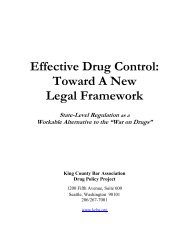RACE AND THE ENFORCEMENT OF DRUG DELIVERY LAWS IN ...
RACE AND THE ENFORCEMENT OF DRUG DELIVERY LAWS IN ...
RACE AND THE ENFORCEMENT OF DRUG DELIVERY LAWS IN ...
You also want an ePaper? Increase the reach of your titles
YUMPU automatically turns print PDFs into web optimized ePapers that Google loves.
Insofar as many drug users knowingly transfer narcotics in the course of their<br />
using activities and facilitate or participate in drug delivery in order to obtain<br />
narcotics, these data suggest that the majority of those who deliver serious drugs<br />
in these contexts are white. The following section considers data sources that<br />
shed more direct light on the racial and ethnic composition of those who deliver<br />
serious drugs in Seattle.<br />
<strong>THE</strong> RACIAL <strong>AND</strong> ETHNIC COMPOSITION <strong>OF</strong> <strong>DRUG</strong> DELIVERERS <strong>IN</strong> SEATTLE<br />
Three data sources provide information about the racial and ethnic composition<br />
of those who deliver serious drugs in Seattle, all of which were also considered in<br />
the previous section of this report. These include SAMHSA’s Survey on Drug Use<br />
and Health, the 2007–2008 Seattle-King County Needle Exchange Survey and the<br />
observational study of the Capitol Hill and downtown drug venues. 76 Because<br />
the methodological issues pertaining to these data sources were described<br />
previously, they are reiterated only briefly in this section. The review of these<br />
data sources indicates that the majority of those who deliver all serious drugs,<br />
with the possible exception of crack cocaine, are white. As noted in the<br />
introduction, this finding stands in sharp contrast to the racial composition of<br />
those purposefully arrested for delivery of a serious drug.<br />
76 Citizen complaints about perceived drug activity are not treated here as a reliable source of<br />
information about the Seattle drug market and its participants, for several reasons. First,<br />
people’s willingness to call 9-1-1 or to file a complaint with the police department is<br />
undoubtedly shaped by a number of personal and social characteristics, none of which are well<br />
understood. That is, not all persons who witness or believe they are witnessing illicit drug<br />
activity will call 9-1-1 to report it. Second, an emerging body of research suggests that racial<br />
stereotypes shape perceptions of the seriousness and/or dangerousness of potentially crimerelated<br />
situations, particularly when information about those situations is limited. For example,<br />
Quillian and Pager (2001) found that the percentage of young black men living in a<br />
neighborhood has a strong positive effect on residents’ perceptions of the level of crime in that<br />
neighborhood and that this effect exists even after crime rates and other objective factors were<br />
taken into account. Similarly, Sampson and Raudenbush (2004) report that residents’<br />
perceptions of neighborhood disorder are significantly affected by the racial, ethnic and class<br />
composition of the neighborhood. Finally, in many cases included in our four-month sample of<br />
9-1-1 calls, resident complaints about perceived drug activity were determined by officers to<br />
have been incorrect and/or unreliable. For example, some 9-1-1 callers reported what they<br />
perceived to be a large group of black teenagers smoking crack; when the police arrived, they<br />
found instead a few youths, some of whom were smoking cigarettes (see Appendix B for other<br />
examples). Although 9-1-1 calls and other narcotics complaints are not a reliable source of<br />
information about the demographic characteristics of those who use and distribute illicit drugs,<br />
they are a source of information about citizen complaints regarding drug use and will be<br />
analyzed in that context.<br />
40

















